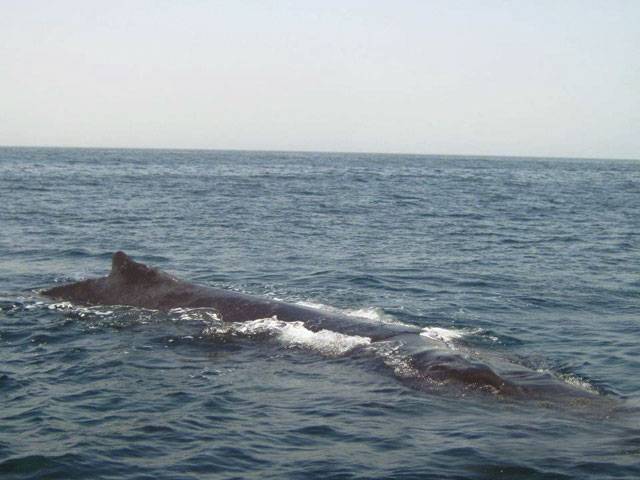KARACHI-A humpback whale was spotted near Jiwani between Gunz and Pishukan area in Pakistani waters on October2, 2010.The whale was spotted by officials of Balochistan Fisheries Department (BFD) during their routine patrol for monitoring illegal trawling activities in local waters. The information was soon conveyed to WWF-Pakistan according to which the whale was alone and was approximately 50m away from BFD boat.It surfaced twice very briefly for breathing and then went for a long dive after showing its tail fluke. Humpback whales are easily recognisable due to their long pectoral fins which can be up to 15 feet long. The scientific name of this species is Megaptera novaeanglia. It is baleen whale which means it does not possess teeth and feeds by filtering its prey (small fish, crustaceans) from large volumes of water by using baleen plates which are brush like structures that hang from their upper jaw. The size of this species can be up to 15m however, like other baleen whale females are larger and can grow up to 18m in length.Humpback whales are very popular among whale watchers due to their tendency to perform amazing acrobatic such as jumping out of water and slapping the water with pectoral fins, tails and head. The sightings and stranding of humpback whales are recorded every now and then along Pakistan coast, thanks to the increased awareness among fishers, local coastal communities and fisheries and wildlife officials due to research and awareness raising efforts by Cetacean Conservation Pakistan Project (CCP) of which WWF-Pakistan was an active member. Any information regarding this species is extremely important considering the fact that the Arabian Sea humpback whale has been declared “Endangered” by IUCN Red List of Threatened Species since 2008. The Arabian Sea humpback whales is unique from other known populations of this species in world in the sense that it is generally thought that this populations feeds and breeds in the same area (the Arabian Sea) and does not carry out very long migration to polar waters for feeding. This means that humpback whales can be seen year round in the Arabian Sea. However, recent research in Oman which is also the key concentration area for this population showed that the number of this species in Omani waters is below 100. This number shows that population is severely depleted mainly because of illegal Russian whaling in 1960s in the Arabian sea including waters off of Pakistan coast and still not able to replenish itself from this great loss in past. The species is vulnerable to escalating threats specifically from unregulated fishing activities.According to Rab Nawaz, Regional Director WWF Pakistan collaboration between all range states in the Arabian Sea are required if we are to save this charismatic creature for our future generations. He went to say that ‘WWF-Pakistan is trying to establish collaboration with regional cetacean research groups so that the efforts for conservation of this endangered population can be coordinated to make them more focused and purposeful, the information obtained through research activities will be used for raising awareness in fishers, coastal communities and general public’It is hoped that collaborative efforts and research and awareness raising efforts will help ensuring future survival of the Arabian Sea in general and Pakistan coast in particular, he added.
Friday, April 19, 2024
Endangered Arabian Sea humpback whale spotted along Pakistan coast

A Tense Neighbourhood
April 19, 2024
Dubai Underwater
April 19, 2024
X Debate Continues
April 19, 2024
Cartoon
April 19, 2024
Hepatitis Challenge
April 18, 2024
IMF Predictions
April 18, 2024
Wheat War
April 18, 2024
Rail Revival
April 17, 2024
Addressing Climate Change
April 17, 2024
Justice denied
April 18, 2024
AI dilemmas unveiled
April 18, 2024
Tax tangle
April 18, 2024
Workforce inequality
April 17, 2024
New partnerships
April 17, 2024
ePaper - Nawaiwaqt
Advertisement
Nawaiwaqt Group | Copyright © 2024





